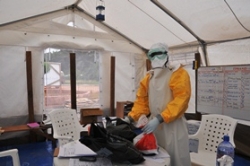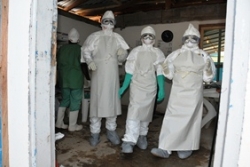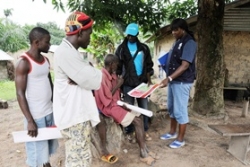Leadership and coordination

- Set up an intersectoral coordination mechanism for information sharing, periodic risk assessment and managing the national and international operational response should cases occur.
- Provide regular advice to the travellers going to Ebola-affected countries on effective public health measures for limiting exposure.
Screening at points of entry as required under the International Health Regulations (IHR 2005)

- Increase awareness of points of entry officials on the risk of importation of EVD case.
- Reinforce the team managing the screening of arriving passengers at the points of entry by deploying additional manpower.
- Ensure that the points of entry officials are appropriately trained for assessment, screening and detection of any suspected case with EVD.
- Ensure availability of measures for isolation of suspected case (possibly in a separate isolation/quarantine space) for investigation and management.
- Ensure there is effective coordination for information sharing and reporting between the designated points of entry officials and the Ministry of Health.
Related reading
Ebola event management at points of entry
Interim guidance for public health authorities and the transport sector
Enhancing surveillance for contact tracing and monitoring

- Enhance surveillance for cluster of unexplained deaths or febrile illness in countries with links to ground border crossing.
- Disseminate case definition of EVD to all health care facilities.
- Develop a protocol for active surveillance, contact tracing and monitoring of close contacts of any suspected case detected or identified either at the points of entry or through the nation’s disease surveillance system.
- Ensure that the relevant staff are trained on field epidemiology, investigation and data management.
Related reading
Case definition recommendations for Ebola or Marburg Virus Diseases
Reinforcing infection control precautions in health care settings

- Identify, designate and establish (where necessary) appropriate isolation units for patient care.
- Ensure availability of sufficient quantities of personal protective equipment (PPEs) and other disinfectant materials at point of care.
- Ensure that the health care workers are appropriately trained on the use specially properly donning and doffing PPEs and other barrier nursing practices for care of EVD patient in health care facilities.
- Train staff on collection, storage and transportation of samples from suspected case and deactivation of specimens ensuring appropriate bio-security measures.
Related reading
Infection prevention and control (IPC) guidance summary
Improving access to quality diagnostics testing and rapid turnaround of results

- Establish a process for rapid shipment of specimens to WHO reference laboratory.
- Ensure capacity to perform routine diagnostic testing.
Related reading
Clinical management of patients with viral haemorrhagic fever
Improving social mobilization, and risk communication for Ebola

- Provide essential information on EVD to general and at-risk populations (health care workers, for example).
- Advise identified target audiences (healthcare workers and family members) on what can be done to prevent the virus from spreading.
- Develop key messages on preparedness, and modify as the situation evolves.
- Develop communications products for various target groups.
- Ensure capacity to perform social mobilization and risk communication if and when outbreak occurs.
Related reading
A toolkit for behavioural and social communication in outbreak response
These public health measures and operational guidance need to be packaged and implemented at national level in consistency with WHO’s evidence-informed guidelines and recommendations.


